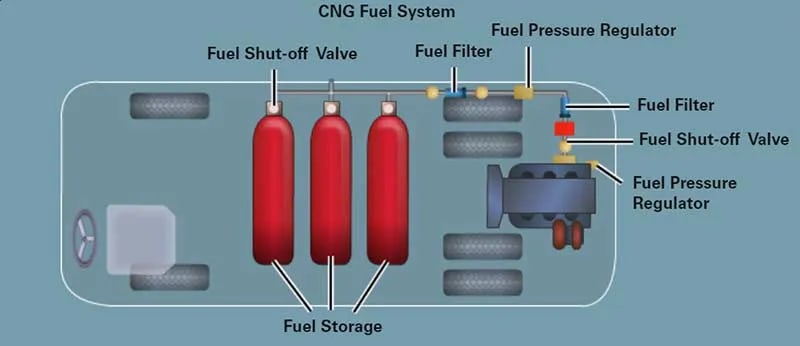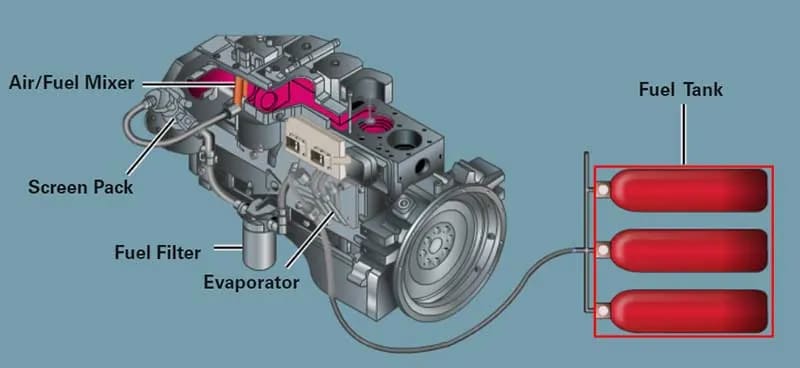Diesel Truck Maintenance: Essential Tips for Longevity
Preventative maintenance on your diesel truck can make a big difference. We share why it's important and a complete preventative maintenance checklist.
If you’re an experienced diesel technician or are considering a career in the field, you may be familiar with the various types of natural gases, which serve as alternatives to conventional petroleum-based fuels.
The world we live in today relies heavily on diesel fuel, but due to environmental concerns and cost efficiency, more and more industries are turning to CNG, LPG and LNG fuel. In the last decade, we’ve seen new applications for natural gas emerge in the transportation, retail and industrial sectors. As a result, it’s important for today’s diesel technicians to stay ahead of the curve and understand these different types of gases and how they work.
There has been a shift in the diesel industry towards using alternative fuels like compressed natural gas (CNG), liquefied petroleum gas (LPG), and liquefied natural gas (LNG) due to environmental concerns and cost efficiency. These fuels are becoming more prevalent in transportation, retail and industrial sectors, necessitating diesel technicians to familiarize themselves with these alternatives.
What is CNG gas? CNG is described as an odorless, tasteless and non-toxic gas primarily composed of methane, offering a cleaner combustion process with lower greenhouse gas emissions compared to traditional fuels. LPG, a byproduct of extracting crude petroleum, is a mixture of propane and butane known for emitting fewer hydrocarbons and increasing engine longevity. LNG, a natural gas cooled into a liquid form, is praised for its cost-effectiveness in storage and transportation due to its reduced volume.
CNG, LPG and LNG have notable differences in composition, storage and application. CNG is highlighted for its safety and lower production costs while LNG is favored by long-haul trucking for its energy density. LPG is distinguished by its use in various industries beyond transportation, including refrigeration and home heating.
There is a growing demand for technicians skilled in working with alternative fuels like CNG, LPG, and LNG. Knowledge of these fuels is required in a wide range of roles and industries, from transit authorities to power generation.
Keep reading to learn the basics of CNG, LPG and LNG fuel, and how these natural gases are impacting the industry.
In the diesel industry, you will hear the acronym CNG used quite often. You may have even seen the blue diamond CNG sticker on commercial vehicles and mass transit buses and wondered, “What is CNG fuel?”
CNG stands for compressed natural gas. It is the gaseous product of petroleum and the first product separated during the distillation process. CNG is odorless, tasteless and non-toxic, and is made up of 93.05% methane, nitrogen, carbon dioxide, propane and traces of ethane. It is an environmentally clean alternative fuel, as its combustion process emits a lower percentage of greenhouse gases when compared to other fuels.

While CNG fuel won’t give you the same amount of power that would come from diesel fuel, it certainly has its advantages. CNG has a high-octane rating that provides a high compression ratio and is adaptable to modern engines. The combustion of CNG produces less carbon monoxide, hydrocarbons and oxides of nitrogen. Overall, this type of gas can help in reducing pollution, as it is a clean-burning fuel.
CNG is a cleaner alternative to traditional gasoline and diesel fuels that is widely recognized for its environmental and economic benefits. As a fossil fuel substitute, CNG significantly reduces harmful emissions, including carbon monoxide, nitrogen oxides and particulate matter, making it an eco-friendlier option for powering vehicles.
The use of CNG in a variety of vehicles from passenger cars to heavy-duty trucks is growing due to its cost-effectiveness. CNG is not only less expensive than gasoline and diesel, but it also helps in prolonging engine life and reducing maintenance costs.
Liquefied petroleum gas (LPG) fuel is an efficient energy source composed of propane and butane. It is commonly used for heating and cooking and as an alternative fuel for vehicles. LPG offers several benefits, including cost-effectiveness and a lower environmental impact compared to traditional fossil fuels like gasoline and diesel.
As an alternative fuel, LPG is gaining popularity in the automotive industry due to its ability to significantly reduce harmful emissions, including carbon dioxide, nitrogen oxides and particulate matter. Additionally, LPG-fueled vehicles often experience lower maintenance costs and longer engine life.
Liquefied natural gas (LNG) fuel is a clean, efficient energy source derived from natural gas, primarily composed of methane. Through a process of cooling natural gas to -259.6 F, it becomes a liquid, significantly reducing its volume and making it easier to transport and store. LNG is commonly used in power generation and industrial applications, and as an alternative fuel for vehicles, including heavy-duty trucks and marine vessels.
Its benefits include cost-effectiveness, as natural gas prices are generally lower and more stable than traditional fossil fuels like gasoline and diesel. LNG also produces fewer harmful emissions.
In addition to CNG fuel, LPG and LNG are two other common alternatives to gas and diesel fuel. Each of these types of fuels has similarities and differences.
LPG fuel, or liquefied petroleum gas, is a liquefied gas and a byproduct derived while extracting crude petroleum. LPG weighs twice as much as air and is a colorless, odorless and highly flammable explosive gas. It is comprised of propane mixed with butane, traces of propylene and butylene.

One of the advantages of LPG is that it emits less hydrocarbons, carbon monoxide and oxides of nitrogen. It also has a high-octane rating and increases engine longevity. The fuel weight-to-mileage of LPG is equal to that of gasoline-operated vehicles.
LNG fuel, or liquefied natural gas, is a natural gas converted to liquid form through liquefaction. During this process, natural gas is cooled until it turns into a liquid, and the volume of gas is reduced by approximately 600 times.
LPG is comprised of 95% methane, and other components include nitrogen, ethane, carbon dioxide and propane. It is non-toxic and non-corrosive, resulting in less pollution. It occupies 1/600 the volume as natural gas, making it much more cost-effective for storage and transportation.
LPG and LNG are both alternative fuels but differ significantly in composition, production processes, applications and environmental impacts.
LPG is primarily composed of propane and butane, while LNG is predominantly methane. LPG is produced as a byproduct during oil refining and from natural gas extraction, whereas LNG is derived from cooling natural gas to -259.6 F to convert it into a liquid form.
In terms of common uses, LPG is widely utilized for heating, cooking and as a fuel for vehicles, offering benefits such as cost-effectiveness and reduced emissions compared with traditional fossil fuels. LNG, on the other hand, is extensively used in power generation and industrial applications and as an alternative fuel for heavy-duty trucks and marine vessels. It is known for its energy efficiency and lower emissions.
Storage methods also differ. LPG can be stored in pressurized tanks at ambient temperature while LNG requires insulated cryogenic tanks to maintain its low temperature.
The choice between LPG and LNG depends on the specific energy needs, infrastructure and environmental goals of the user.
While liquefied natural gas and compressed natural gas are similar, their delivery and storage methods are different.
LNG is frozen in order to turn it into liquid form, whereas CNG is pressurized to the point where it is very compact. LNG takes up less storage space on a vehicle than CNG and it offers an energy density comparable to diesel fuel. This makes it a common choice among many long-haul trucking companies. Using proper procedures, LNG can be converted to CNG.
On the other hand, CNG is easier to refuel than LNG, which requires special handling and equipment. CNG is also very light, so if there is a leak, it will dissipate. It has an unlimited hold time, so even if it goes unused, there is no fuel loss. This makes CNG a safer choice over LNG. CNG also has lower production costs than LNG.
CNG and LPG fuel also have similarities and differences. While CNG is composed of methane, LPG is composed of propane and butane. CNG is typically used as a substitute for gasoline in automobiles while LPG is often used in the industrial, refrigeration, agricultural and catering industries. It is also used to power cooking and heating in homes, and like CNG, can be used as automobile fuel.
CNG releases less greenhouse gas while LPG releases carbon dioxide but is still cleaner than gasoline. In the case of a spill, CNG quickly dissipates, whereas LPG will settle on the ground. In general, CNG is considered safer than LPG since LPG is difficult to disperse.
Knowing about the different types of alternative fuels can benefit technicians greatly in their diesel careers. Technicians who can work on applications that run on these fuels are important, but there are not enough candidates who have the right skills. This skills gap is opening the door to exciting opportunities for those who are prepared for careers in the diesel industry.
Having CNG, LPG and LNG qualifications may make a technician more valuable overall. Construction equipment, trucks, agricultural equipment and many other applications have already made the switch to natural gas, which means a new generation of technicians will be needed to keep them up and running.
Technicians who possess knowledge of alternative fuels often work for transit authorities and engine manufacturer and dealers and in the power generation industry. Today, nearly every manufacturer makes something that runs on natural gas. No matter where technicians work, they will most likely be exposed to these types of fuels—especially as their popularity grows.
Universal Technical Institute’s 45-week Diesel Technology program is designed to provide you with a foundation of knowledge for the diesel industry.1,7
In addition to learning concepts like truck preventive maintenance, diesel fuel systems and transportation refrigeration, your coursework will cover the different types of alternative fuels and the applications that run on them. Graduates are well prepared to complete ASE examinations and can substitute their training for one of the two years of work experience required to become ASE certified.
As a UTI student, you could also elevate your training with manufacturer-specific education. Created in conjunction with leading brands, UTI’s specialized training programs are designed to provide the skills employers look for.
If pursuing a career in the diesel industry is a passion of yours, UTI is a good place to complete your training. You’ll have the chance to learn alongside other students who share your passion and train on equipment and technology used in the industry. Along the way, you’ll have the support of instructors who will be there to mentor you as you complete your program and graduate.
Request more information to talk with an Admissions Representative about your goals!
Universal Technical Institute of Illinois, Inc. is approved by the Division of Private Business and Vocational Schools of the Illinois Board of Higher Education.